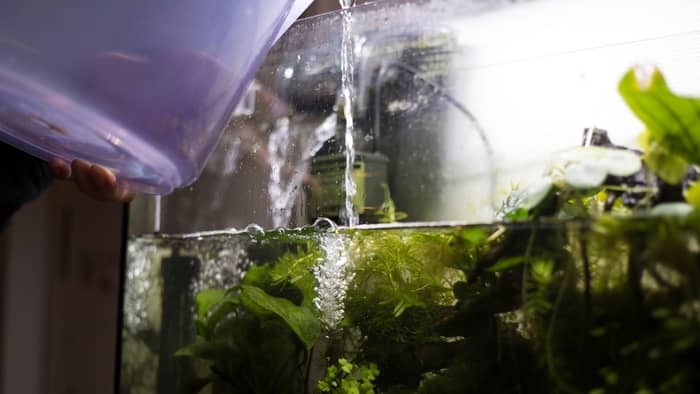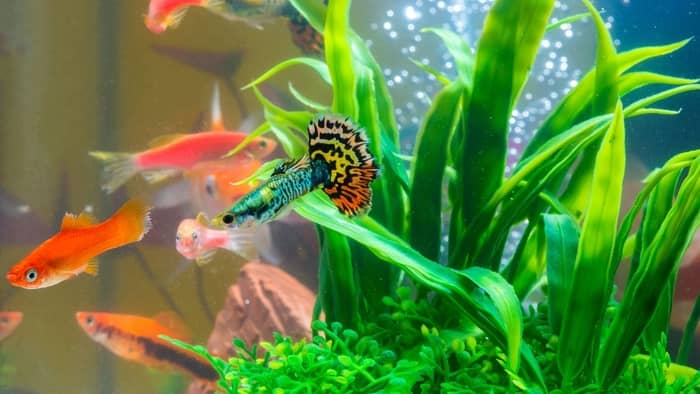Last Updated on October 24, 2022 by admins
When it comes to owning an aquarium, proper maintenance is vital to keeping your fish healthy. Knowing how to reduce nitrites in an aquarium is an important step to keeping your fish healthy. High levels of nitrites can cause huge problems if they are not properly maintained.
Nitrite poisoning, also known as Brown Blood Disease, turns the blood in fish brown due to methemoglobin. Methemoglobin makes the blood unable to carry oxygen, which causes fish to suffocate. Though different types of fish tolerate different types of nitrite levels, it is important to keep the nitrite levels down.
Signs Of High Nitrites in an Aquarium
If you are experiencing high levels of ammonia in your fish tank, high levels of nitrites will follow. It is important to look for signs of elevated nitrites including fish gasping for breath at the surface, fish hanging near water outlets, rapid gill movement, brown gills, and listlessness.
Different species of fish will react differently to high levels of nitrite. Some fish will simply just be listless while others may die with no signs of poisoning.
Learn more about Aquarium Pharmaceuticals Ammonia Test Chart
When to check for high nitrites in an aquarium
To keep your fish healthy, it is important to know when to test for high nitrites. To avoid nitrite poisoning, check the water when adding new fish, after a filter failure and when caring for sick fish.
By testing the water in these circumstances, you can help minimize the chance of your fish getting Brown Blood Disease. You can buy tests online and in stores that will test the nitrites levels in your water.
How to lower nitrites in an aquarium
If you have fish, you will want to know how to fix nitrite levels in fish tanks. This is vital to keep your fish healthy and thriving.
1. Change out the water
One of the first things you should do when reducing the nitrite levels is to change out of the water. Start with changing 30% of the water. By changing just 30% of the water at once, you will make it easier on your fish.
Practice changing 30% of the water every week to keep the water clean and safe. This will help dilute any contamination in the water while keeping good bacteria.

Learn more about: Lowering Nitrates In A Freshwater Aquarium
2. Increase the aeration
Increasing the aeration in your tank will help bring down the nitrite levels. The aeration will help give your fish a healthy environment to live in.
3. Add aquarium salt
Adding a small amount of aquarium salt or rock salt to your aquarium can help enhance the chloride. The chloride will help prevent the nitrites from entering the body of fish.
Add one teaspoon of salt for every 10 gallons of water. Be sure to research the fish and plants in the water to ensure that none of them are extra sensitive to salt.
4. Feed once a day
Feeding once a day can help minimize overfeeding and reduce any leftovers from spoiling. If any food remains after 1o minutes, remove it from the tank.
Be sure to also feed accordingly to the fish in your tank. Know how much food they will need to prevent under and over-feeding. An automatic feeder can be a convenient and efficient way to feed your fish.
5. Get a bottom cleaner
Even with careful feeding, food will end up at the bottom of the tank. To help get rid of this food and keep your tank clean, you can invest in bottom cleaners. Bottom feeders are also affordable and do a great job of keeping the environment in your tank healthy.
6. Add more plants
Not only do plants look good, but they also help the water in your fish tank. Plants can work to absorb excessive levels of nitrites, leaving the water purified. They work to keep the water in your tank clean and create a healthy space for your fish.

7. Don’t add too many fish at once
Adding too many fish at once can overwhelm the environment. By increasing the stock in your tank by adding a large number of fish at once can cause issues with the water. This can lead to an overload of organic matter in your tank which can cause the nitrite levels to rise.
8. Regularly clean the tank filters
It is important to regularly clean the filters in your aquarium. However, when cleaning the filters, clean them with used aquarium water. The chlorine levels in tap water will eliminate the good bacteria in your fish tank.
In addition, do not clean the tank filters all at once. It is also recommended to not clean all the gravel at once, as nitrifying bacteria can be found in the gravel.
Fluval Flex/Spec/Evo Nitrite Remover, Replacement Aquarium Filter Media
9. Clean the tank weekly
Regularly cleaning the tank will help keep the nitrite levels down. Regular cleaning helps rid the water of excess food and waste.
Conclusion – How to Reduce Nitrites in an Aquarium
It is vital to keep the nitrite levels down in your fish tank. When the nitrite levels get too high, this can lead to nitrite poisoning, AKA Brown Blood Disease. This can potentially be fatal in some fish.
Be sure to test the nitrite levels in your tank when adding new fish, after a filter failure and when medicating a sick fish. To help reduce nitrite levels, change 30% of your water weekly, clean every week, add plants, avoid adding too many fish at once, get a bottomer feeder and add salt. In addition, use aquarium water, not tap water, to clean filters, increase the aeration, and feed once daily.
By carefully following these steps, you can ensure that your fish will be kept healthy. A clean tank environment will help reduce the chances of Brown Blood Disease. Be sure to also research your fish before buying them to make sure you supply a proper environment and food.
Do you have any questions on how to reduce nitrites in an aquarium? If so, please ask your aquarium and fish-related questions in the comment section down below.
Read more about: How To Get Rid Of Blue-Green Algae In A Planted Aquarium

Leave a Reply
You must be logged in to post a comment.